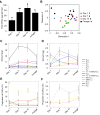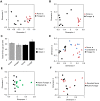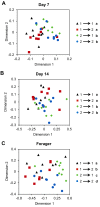The cuticular hydrocarbon profiles of honey bee workers develop via a socially-modulated innate process
- PMID: 30720428
- PMCID: PMC6382352
- DOI: 10.7554/eLife.41855
The cuticular hydrocarbon profiles of honey bee workers develop via a socially-modulated innate process
Abstract
Large social insect colonies exhibit a remarkable ability for recognizing group members via colony-specific cuticular pheromonal signatures. Previous work suggested that in some ant species, colony-specific pheromonal profiles are generated through a mechanism involving the transfer and homogenization of cuticular hydrocarbons (CHCs) across members of the colony. However, how colony-specific chemical profiles are generated in other social insect clades remains mostly unknown. Here we show that in the honey bee (Apis mellifera), the colony-specific CHC profile completes its maturation in foragers via a sequence of stereotypic age-dependent quantitative and qualitative chemical transitions, which are driven by environmentally-sensitive intrinsic biosynthetic pathways. Therefore, the CHC profiles of individual honey bees are not likely produced through homogenization and transfer mechanisms, but instead mature in association with age-dependent division of labor. Furthermore, non-nestmate rejection behaviors seem to be contextually restricted to behavioral interactions between entering foragers and guards at the hive entrance.
Keywords: Apis melifera; ecology; honey bee; social insects.
© 2019, Vernier et al.
Conflict of interest statement
CV, JK, KM, AH, JL, YB No competing interests declared
Figures








References
-
- Akino T, Yamamura K, Wakamura S, Yamaoka R. Direct behavioral evidence for hydrocarbons as nestmate recognition cues in Formica japonica (Hymenoptera: Formicidae) Applied Entomology and Zoology. 2004;39:381–387. doi: 10.1303/aez.2004.381. - DOI
-
- Baracchi D, Petrocelli I, Chittka L, Ricciardi G, Turillazzi S. Speed and accuracy in nest-mate recognition: a hover wasp prioritizes face recognition over colony odour cues to minimize intrusion by outsiders. Proceedings of the Royal Society B: Biological Sciences. 2015;282:20142750. doi: 10.1098/rspb.2014.2750. - DOI - PMC - PubMed
-
- Ben-Shahar Y, Thompson CK, Hartz SM, Smith BH, Robinson GE. Differences in performance on a reversal learning test and division of labor in honey bee colonies. Animal Cognition. 2000;3:119–125. doi: 10.1007/s100710000068. - DOI
Publication types
MeSH terms
Substances
Grants and funding
LinkOut - more resources
Full Text Sources
Other Literature Sources

